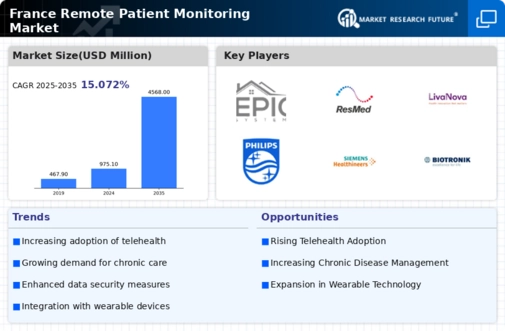Increased Demand for Home Healthcare
The remote patient-monitoring market is experiencing a notable surge in demand for home healthcare solutions in France. This trend is driven by an aging population, with approximately 20% of the French population projected to be over 65 years by 2030. As chronic diseases become more prevalent, patients increasingly prefer to manage their health from the comfort of their homes. The remote patient-monitoring market is responding to this demand by offering innovative solutions that facilitate continuous health monitoring, thereby reducing the need for frequent hospital visits. Furthermore, the French government has been promoting home healthcare initiatives, which further supports the growth of this market. The integration of advanced technologies, such as wearable devices and mobile applications, enhances patient engagement and adherence to treatment plans, ultimately improving health outcomes.
Integration with Telehealth Services
The integration of remote patient-monitoring with telehealth services is emerging as a key driver for the market in France. As healthcare providers increasingly adopt telehealth platforms, the synergy between these services and remote monitoring technologies enhances patient care. This integration allows for real-time data sharing between patients and healthcare professionals, facilitating timely interventions and personalized treatment plans. The remote patient-monitoring market benefits from this trend, as it aligns with the growing preference for virtual consultations among patients. Moreover, the French government has been supportive of telehealth initiatives, which further encourages the adoption of integrated solutions. This collaborative approach not only improves patient outcomes but also streamlines healthcare delivery, making it more efficient and accessible.
Rising Awareness of Chronic Disease Management
There is a growing awareness of chronic disease management among the French population, which significantly impacts the remote patient-monitoring market. With chronic diseases such as diabetes and hypertension affecting a substantial portion of the population, patients are increasingly seeking effective management solutions. The remote patient-monitoring market is responding to this need by providing tools that empower patients to monitor their health metrics regularly. Educational campaigns and initiatives by healthcare organizations have contributed to this heightened awareness, encouraging patients to take an active role in their health management. As a result, the demand for remote monitoring solutions that facilitate chronic disease management is expected to rise, driving market growth in the coming years.
Technological Innovations in Health Monitoring
Technological innovations are a fundamental driver of the remote patient-monitoring market in France. The advent of advanced wearable devices, mobile health applications, and artificial intelligence has transformed how health data is collected and analyzed. These innovations enable continuous monitoring of vital signs and health parameters, providing healthcare professionals with valuable insights into patient conditions. The remote patient-monitoring market is leveraging these technologies to enhance the accuracy and reliability of health assessments. Furthermore, the increasing penetration of smartphones and internet connectivity in France facilitates the adoption of these technologies among patients. As technology continues to evolve, it is likely that the remote patient-monitoring market will witness further advancements, leading to improved patient outcomes and more efficient healthcare delivery.
Cost-Effectiveness of Remote Monitoring Solutions
Cost considerations play a pivotal role in the expansion of the remote patient-monitoring market in France. Healthcare providers are increasingly recognizing the financial benefits associated with remote monitoring solutions. By enabling early detection of health issues, these solutions can potentially reduce hospital admissions and emergency room visits, which are costly for both patients and healthcare systems. Studies indicate that implementing remote monitoring can lead to a reduction in healthcare costs by up to 30%. This cost-effectiveness is particularly appealing to both public and private healthcare sectors in France, as they seek to optimize resource allocation while maintaining high-quality care. The remote patient-monitoring market is thus positioned to thrive as stakeholders prioritize solutions that deliver both clinical and economic value.





















Leave a Comment